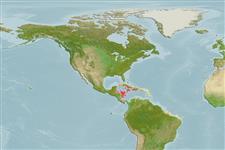Teleostei (teleosts) >
Blenniiformes (Blennies) >
Labrisomidae (Labrisomids)
Etymology: robertsoni: Named in recognition of the contributions by D. Ross Robertson of the Smithsonian Tropical Research Institute to the understanding of the diversity of shorefishes of the New World and his generous facilitation of collecting in Panama.
Eponymy: Edwin Chapin Starks (1867–1932) was an American ichthyologist who was an authority on the osteology of fish. [...] Dr David Ross Robertson (d: 1946) is an ichthyologist whose bachelor’s degree (1966) and doctorate (1974) were awarded by The University of Queensland, Australia. [...] (Ref. 128868), visit book page.
Environment: milieu / climate zone / depth range / distribution range
Ecology
Marine; benthopelagic; depth range 5 - 15 m. Tropical
Atlantic Ocean: Panama.
Size / Weight / Age
Maturity: Lm ? range ? - ? cm
Max length : 2.1 cm SL male/unsexed; (Ref. 86414); 2.2 cm SL (female)
Short description
Identification keys | Morphology | Morphometrics
Dorsal spines (total): 19 - 20; Dorsal soft rays (total): 7; Anal spines: 2; Anal soft rays: 16; Vertebrae: 31 - 32. This species of Starksia is distinguished by the following set of characters: orbital cirrus present; belly scaled; trunk pale to dark tan (dark orange/tan to bright orange in life), without distinct bars or other markings; lips without conspicuous white spotting in life; ventral surface of lower jaw of males with one to three dark blotches or bars in preserved specimens, lips without distinct banding or dark bars; dorsal-fin elements usually XX,7 – 27 total; vertebrae usually 10+22=32; dorsal spines + anal soft rays + vertebrae modally 75 (Ref. 86414).
Depth range (5-15 m) given by B. Victor (pers. comm. 10/18).
Life cycle and mating behavior
Maturity | Reproduction | Spawning | Eggs | Fecundity | Larvae
Baldwin, C.C., C.I. Castillo, L.A. Weigt and B.C. Victor, 2011. Seven new species within western Atlantic Starksia atlantica, S. lepicoelia, and S. sluiteri (Teleostei, Labrisomidae), with comments on congruence of DNA barcodes and species. ZooKeys 79:21-72. (Ref. 86414)
IUCN Red List Status (Ref. 130435: Version 2024-2)
Threat to humans
Harmless
Human uses
Fisheries: of no interest
Tools
Special reports
Download XML
Internet sources
Estimates based on models
Phylogenetic diversity index (Ref.
82804): PD
50 = 0.5000 [Uniqueness, from 0.5 = low to 2.0 = high].
Bayesian length-weight: a=0.00537 (0.00222 - 0.01301), b=3.08 (2.87 - 3.29), in cm total length, based on LWR estimates for this (Sub)family-body shape (Ref.
93245).
Trophic level (Ref.
69278): 3.2 ±0.4 se; based on size and trophs of closest relatives
Fishing Vulnerability (Ref.
59153): Low vulnerability (10 of 100).
